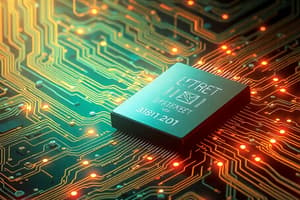Podcast
Questions and Answers
What does electronics primarily control?
What does electronics primarily control?
- Chemical reactions
- Thermal energy
- Magnetic fields
- The flow of electricity (correct)
Which of the following is not one of the three SI base units mentioned?
Which of the following is not one of the three SI base units mentioned?
- Celsius (correct)
- Kilogram
- Second
- Meter
How many SI base units are there in the metric system?
How many SI base units are there in the metric system?
- Seven (correct)
- Six
- Five
- Eight
Which of the following primarily affects the behavior of electrons in materials?
Which of the following primarily affects the behavior of electrons in materials?
What is the significance of the basic mathematics in electronics?
What is the significance of the basic mathematics in electronics?
What is the primary characteristic of direct current (DC)?
What is the primary characteristic of direct current (DC)?
How do electrons behave in an alternating current (AC) circuit?
How do electrons behave in an alternating current (AC) circuit?
Which of the following is a source of direct current (DC)?
Which of the following is a source of direct current (DC)?
What occurs in an electric circuit when a voltage is applied across a conductor?
What occurs in an electric circuit when a voltage is applied across a conductor?
What is the flow of charge in an electric circuit generally referred to as?
What is the flow of charge in an electric circuit generally referred to as?
What is the primary function of a capacitor in an electronic circuit?
What is the primary function of a capacitor in an electronic circuit?
Which of the following components is classified as an active electronic component?
Which of the following components is classified as an active electronic component?
What is the role of a diode in an electronic circuit?
What is the role of a diode in an electronic circuit?
In an LED, which side is the anode?
In an LED, which side is the anode?
Which statement accurately describes integrated circuits (ICs)?
Which statement accurately describes integrated circuits (ICs)?
Which of the following is NOT a passive electronic component?
Which of the following is NOT a passive electronic component?
How do capacitors react to a drop in voltage in a circuit?
How do capacitors react to a drop in voltage in a circuit?
What differentiates an LED from a standard diode?
What differentiates an LED from a standard diode?
What is the primary purpose of a helping hand tool in electronics?
What is the primary purpose of a helping hand tool in electronics?
Which type of wire is typically used for jumper wires in breadboards?
Which type of wire is typically used for jumper wires in breadboards?
What is the purpose of heat shrink tubing in electronics?
What is the purpose of heat shrink tubing in electronics?
When soldering electronic components, which tool is necessary?
When soldering electronic components, which tool is necessary?
Which statement accurately describes solder in electronics?
Which statement accurately describes solder in electronics?
What defines 1 volt in terms of current and power?
What defines 1 volt in terms of current and power?
Which of the following statements correctly describes 1 ohm?
Which of the following statements correctly describes 1 ohm?
What can voltage be expressed in terms of?
What can voltage be expressed in terms of?
What are SI derived units in the context of electricity?
What are SI derived units in the context of electricity?
If 1 volt is applied to a conductor and a current of 1 ampere flows, what is the resistance?
If 1 volt is applied to a conductor and a current of 1 ampere flows, what is the resistance?
What is one advantage of using AC over DC for electricity generation?
What is one advantage of using AC over DC for electricity generation?
What is the primary reason for transforming electrical energy before it enters homes?
What is the primary reason for transforming electrical energy before it enters homes?
What role do transformers play in the distribution of electricity?
What role do transformers play in the distribution of electricity?
Why is it necessary to use low current and high voltage for long-distance electricity transmission?
Why is it necessary to use low current and high voltage for long-distance electricity transmission?
What characteristic of AC is particularly beneficial for electrical transmission?
What characteristic of AC is particularly beneficial for electrical transmission?
What is the primary function of a fuse in an electrical circuit?
What is the primary function of a fuse in an electrical circuit?
How does a circuit breaker differ from a fuse?
How does a circuit breaker differ from a fuse?
What is the primary purpose of a Ground Fault Interrupter (GFI)?
What is the primary purpose of a Ground Fault Interrupter (GFI)?
What might happen if a circuit breaker does not function correctly?
What might happen if a circuit breaker does not function correctly?
Which of the following statements is true about fuses?
Which of the following statements is true about fuses?
What is the function of a load in an electric circuit?
What is the function of a load in an electric circuit?
Which circuit symbol indicates that wires are not connected but merely crossing each other?
Which circuit symbol indicates that wires are not connected but merely crossing each other?
What is the main distinction between a cell and a battery?
What is the main distinction between a cell and a battery?
Which of the following supplies electrical energy as a direct current (DC)?
Which of the following supplies electrical energy as a direct current (DC)?
What is the primary purpose of circuit symbols in schematic diagrams?
What is the primary purpose of circuit symbols in schematic diagrams?
What role does the source of electrical energy play in a circuit?
What role does the source of electrical energy play in a circuit?
What happens to energy in an electric circuit due to resistance?
What happens to energy in an electric circuit due to resistance?
Which type of circuit allows current to flow even if one device fails?
Which type of circuit allows current to flow even if one device fails?
What is the primary purpose of a fuse or circuit breaker in an electrical circuit?
What is the primary purpose of a fuse or circuit breaker in an electrical circuit?
In a series circuit, what is true about the current flowing through each device?
In a series circuit, what is true about the current flowing through each device?
What describes the arrangement of devices in a parallel circuit?
What describes the arrangement of devices in a parallel circuit?
What effect does an open switch have on the flow of current in a circuit?
What effect does an open switch have on the flow of current in a circuit?
What is an essential characteristic of a series circuit compared to a parallel circuit?
What is an essential characteristic of a series circuit compared to a parallel circuit?
What is the relationship between current and resistance as defined by Ohm's Law?
What is the relationship between current and resistance as defined by Ohm's Law?
What creates a potential difference that drives current in a circuit?
What creates a potential difference that drives current in a circuit?
Which materials are classified as ohmic according to Ohm's Law?
Which materials are classified as ohmic according to Ohm's Law?
What is the unit of measurement used for resistance?
What is the unit of measurement used for resistance?
If the voltage applied to a resistor is increased, what happens to the current assuming resistance remains constant?
If the voltage applied to a resistor is increased, what happens to the current assuming resistance remains constant?
How does resistance relate to the flow of charge?
How does resistance relate to the flow of charge?
What is the formula derived from Ohm's Law that relates voltage, current, and resistance?
What is the formula derived from Ohm's Law that relates voltage, current, and resistance?
What does a higher resistance indicate about a substance's ability to conduct current?
What does a higher resistance indicate about a substance's ability to conduct current?
Who was the physicist that first demonstrated the relationship between current and voltage?
Who was the physicist that first demonstrated the relationship between current and voltage?
What happens to the current if the resistance in a circuit is decreased while the voltage is constant?
What happens to the current if the resistance in a circuit is decreased while the voltage is constant?
Flashcards are hidden until you start studying
Study Notes
Electronic Components and Their Functions
- Electronic Components: Essential parts that connect to form a circuit, e.g., amplifiers and radios.
- Types of Components:
- Active Components: Have gain or directionality (e.g., transistors, integrated circuits).
- Passive Components: Lack gain or directionality (e.g., resistors, capacitors, inductors).
- Capacitors: Store and discharge electrical charge; function like rechargeable batteries.
- Diodes: Conduct electricity in one direction, preventing undesired current flow.
- Light-Emitting Diode (LED): Emits light when current flows through; current flows from anode (+) to cathode (-).
- Integrated Circuits (ICs): Compact circuits containing multiple basic electronic components in a single chip.
Basic Electronics and SI Units
- Electronics Defined: The study of electrical energy flow and control using components, essential for devices like TVs and radios.
- SI Base Units:
- Length (m), Mass (kg), Time (s) – foundational units for measurement.
Electricity: AC vs. DC
- Current Flow: Movement of electric charge; direction of flow influenced by voltage.
- Direct Current (DC): Unidirectional current; generated by batteries.
- Alternating Current (AC): Fluctuating current direction; allows efficient energy transmission over long distances.
- Voltage Definition: Measured in volts; the potential difference that drives current.
- Ohm's Law: Establishes a relationship between voltage (V), current (I), and resistance (R); expressed as I ∝ V, R ∝ 1/I.
Electrical Safety Devices
- Fuses: Break circuits if current exceeds safe levels, preventing appliance damage.
- Circuit Breakers: Automatically disconnect circuits when excess current is detected, averting fire risks.
- Ground Fault Interrupters (GFIs): Detect small current leaks; trip circuits to prevent electric shock.
Simple Electrical Circuit Components
- Essential Components:
- Source of Energy: Provides voltage; could be a battery or hydroelectric plant.
- Device: The appliance that uses electrical energy.
- Resistance: Always present; affects energy transfer and may generate heat.
- Circuit Types:
- Series Circuits: Components connected in a single loop; same current flows through each.
- Parallel Circuits: Each device connected across the same voltage; allows individual device operation.
Circuit Diagram Symbols and Functions
- Wire Symbol: Represents current passage between circuit components.
- Cell/Battery Symbols: Represent sources of electrical energy.
- AC/DC Supply Symbols: Denote types of electrical energy sources used in circuits.
Studying That Suits You
Use AI to generate personalized quizzes and flashcards to suit your learning preferences.




